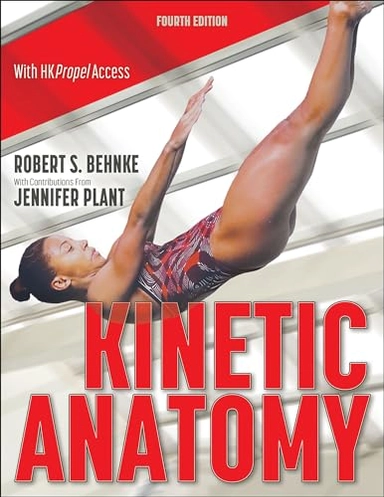This is the loose-leaf version of Kinetic Anatomy, Fourth Edition, which offers students a less expensive, printed version of the text.
Kinetic Anatomy, Fourth Edition With HKPropel Access, gives students a firm concept of musculoskeletal anatomy by systematically assembling each component of the human body. Layer by layer, readers will study bones, ligaments, joints, and muscles as well as the nerves and blood vessels that supply these muscles that are essential for movement.With full-color visual aids and activities that invite readers to apply their understanding of structural anatomy to their own lives, the fourth edition is ideally suited for students studying physical activity because it explores how the structural anatomy of the human body facilitates movement.
Part I of the text introduces the basics of structural anatomy. It describes how bones, joints, muscles, nerves, and other essential anatomy work together to allow for fundamental movement. Part II details the anatomy of the upper extremity region, including the shoulder, elbow, forearm, wrist, and hand. Part III of the text explores the anatomy of the head, spinal column, thorax, and pelvis. These chapters include unique coverage not found in other anatomy texts, explaining how the brain, heart, and lungs—as the power centers of the nervous, cardiovascular, and respiratory systems—affect movement. Part IV discusses the anatomy of the lower extremity region: the hip, thigh, knee, lower leg, ankle, and foot. Parts II, III, and IV each end with a summary table that offers a quick reference for the components of the body region featured in that part.
Kinetic Anatomy, Fourth Edition, contains nearly 400 photos, illustrations, and infographics to help readers visualize structural anatomy and engage with their coursework. Throughout the book, Hands On exercises instruct readers to physically identify anatomical structures on themselves or on a partner, and Focus On sidebars illustrate circumstances in everyday activity that relate to the specific anatomical structures in the text. Pop quizzes provide readers an opportunity to strengthen their clinical reasoning skills by asking them to identify the muscles shown in the accompanying photo. The fourth edition is further enhanced with the addition of new online learning tools —all of which can be assigned, and progress tracked, by instructors directly through HKPropel: Anatomy labeling and coloring sheets offer students nearly 100 interactive activities that test their knowledge of anatomical structures and function. Learning activities; true-false, multiple-choice, and fill-in-the-blank questions; and functional movement exercises ensure students have a firm grasp of key points from each chapter. Chapter quizzes (assessments) may also be assigned; these are automatically graded to test comprehension of critical concepts. Readers of Kinetic Anatomy, Fourth Edition, will learn what structures are involved in movement and how those structures should function, allowing them to identify problems and correct them to enhance physical activity. Anyone interested in just how their body functions during physical activity and how certain overuse or misuse can affect certain anatomical structures will benefit from this book.
Earn continuing education credits/units! A continuing education course and exam that uses this book is also available. It may be purchased separately or as part of a package that includes all the course materials and exam.
Note: A code for accessing HKPropel is included with all new print books.
Åtkomstkoder och digitalt tilläggsmaterial garanteras inte med begagnade böcker





















